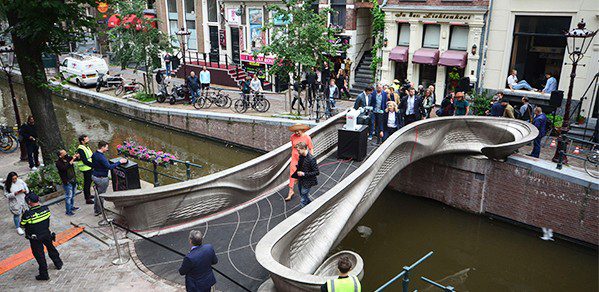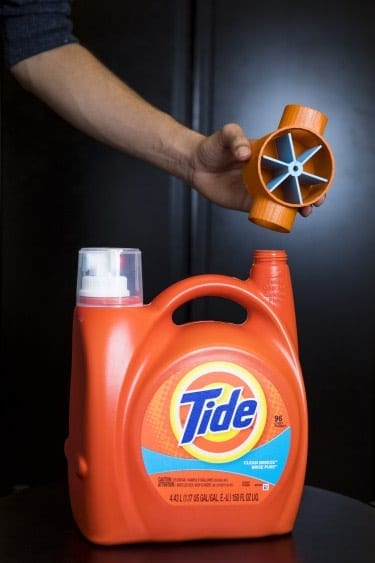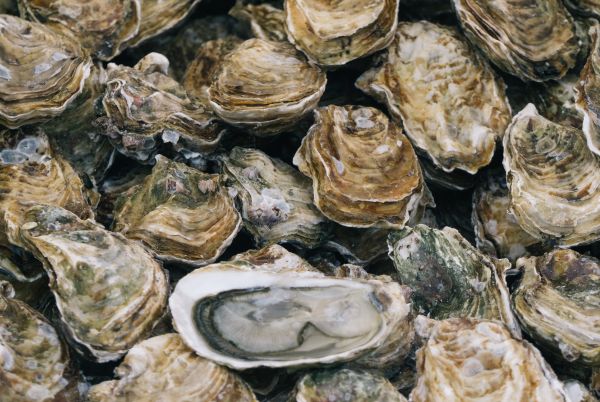
During the opening of the bridge by Her Majesty Queen Máxima of the Netherlands.
Credit: MX3D / Adriaande Groot
The world’s first 3D printed steel bridge has been installed and unveiled in Amsterdam – with the potential to revolutionise how urban infrastructure is designed, built and maintained. Project lead Professor Mark Girolami led the structural integrity testing, as well as the design and installation of the bridge’s sensor network. The team from the Department of Engineering and The Alan Turing Institute are currently working on developing and deploying a ‘digital twin’ of the bridge.
When we couple 3D printing with ‘digital twin’ technology, we can then accelerate the infrastructure design process, ensuring that we design optimal and efficient structures with respect to environmental impact, architectural freedom and manufacturing costs.
Professor Mark Girolami
The futuristic multi award-winning bridge, designed by Joris Laarman Lab, with Arup as lead engineer, has been placed over one of the oldest canals in Amsterdam’s city centre, the Oudezijds Achterburgwal canal. The bridge was officially opened on 15 July by Her Majesty Queen Máxima of the Netherlands.
Printed by Dutch technology MX3D using robotic arms, the 12 metre-long bridge is also equipped with an innovative sensor network, linked to a mathematical computer model forming a ‘digital twin’ of the physical bridge and its digital representation. The ‘digital twin’ monitors the bridge performance in real-time. The ‘smart’ bridge, in effect, serves as a living laboratory, with pedestrians, cyclists and runners generating data every time they cross the bridge. This data will help to monitor the bridge’s structure and provide information about how it is being used.
More than 100 sensors attached to the bridge will monitor strain, movement, vibrations and weather conditions as people cross it. The data collected will be sent to a ‘digital twin’ of the bridge, which will help engineers assess how the bridge is faring, alerting them if problems occur and when maintenance might be required. The data will also provide input and lessons learned for future builds, helping designers understand how 3D-printed steel could be used in more complex projects. Statistical methodology will be utilised to understand more about the material itself and machine learning will be used to spot trends in the data pointing to potential changes, issues of maintenance or necessary modifications.
Dr Mohammed Elshafie, CSIC Co-Investigator, has been collaborating with the DCE and MX3D to measure, monitor and analyse the performance of the bridge. The overall project was led by Professor Girolami, Sir Kirby Laing Professor of Civil Engineering, Royal Academy of Engineering Research Chair at the University of Cambridge, Academic Lead for CSIC and Programme Director for Data-Centric Engineering at The Alan Turing Institute.
“3D printing is poised to become a major technology in engineering, and we need to develop appropriate approaches for testing and monitoring to realise its full potential,” said Professor Girolami. “When we couple 3D printing with ‘digital twin’ technology, we can then accelerate the infrastructure design process, ensuring that we design optimal and efficient structures with respect to environmental impact, architectural freedom and manufacturing costs.”
3D printed steel is a new material, which may have the power to radically change conventional construction and overhaul the building industry. Load testing and materials testing conducted by the Turing DCE team, proved that the bridge is able to hold at least a 19.5 ton load, well above its ultimate design load.
Original Article: Structural health of world’s first 3D printed steel bridge monitored by sensors and ‘digital twin’ technologies
More from: University of Cambridge | Alan Turing Institute
The Latest Updates from Bing News & Google News
Go deeper with Bing News on:
3D printed steel
- INDO-MIM taps 3D printing in precision manufacturing
The precision metal parts manufacturer is using HP’s Metal Jet S100 printers to produce components using metal powder for the automotive, healthcare and other industries ...
- Rice University Students Develop Affordable Metal 3D Printer Prototype Using Cold-Spray Technology
Students at Rice University have developed an incredibly inexpensive metal 3D printer prototype. Researchers at Virginia Tech have taken on a big challenge: making wind turbines sustainable.
- Students build low-cost cold spray metal 3D printer prototype
A team of Rice University students has developed a cold spray metal 3D printing device that relies on pressure and velocity rather than temperature to create a metal part. Their work could help expand ...
- Materialise and Renishaw announce partnership to increase efficiency of metal 3D printing
Renishaw’s innovative scanning algorithms combined with Materialise’s accelerated build processors shorten production time ...
- Farsoon’s New SRS Tech Reduces Metal 3D Printing Support Needs
Farsoon introduced an almost unreal method of printing support structures for metal 3D prints. Researchers have developed a unique approach to direct ink writing that has the ability to vary softness ...
Go deeper with Google Headlines on:
3D printed steel
[google_news title=”” keyword=”3D printed steel” num_posts=”5″ blurb_length=”0″ show_thumb=”left”]
Go deeper with Bing News on:
3D printed steel bridge
- Makers of the world’s largest 3D printer just beat their own record
After a five-year reign, the world’s largest 3D printer located at the University of Maine has been usurped—by a newer, larger 3D printer developed at the same school.
- This is the world's largest 3D printer: The University of Maine breaks its own record
Forward-looking: The University of Maine has broken its own 2019 Guinness World Record with a next-gen polymer 3D printer that is four times the size of its predecessor. Dubbed Factory of the Future 1 ...
- Playbook: Pecker nips at Trump’s defense
TRUMP’S PECKER PROBLEM — The Manhattan hush money case has frequently been described as the weakest of the four criminal cases against DONALD TRUMP. But whatever the jury decides about the legal ...
- UltiMaker Targets Experienced Additive Manufacturers with New Factor 4
Industrial-grade 3D printer focuses on reliability, with automatic material handling and in-process monitoring.
- World's biggest 3D printer unveiled in US will make entire recyclable neighbourhoods, say officials
The University of Maine said the printer offers "new opportunities for eco-friendly and cost-effective" manufacturing and will be able to produce objects as large as 96-foot long and 32-foot wide.
Go deeper with Google Headlines on:
3D printed steel bridge
[google_news title=”” keyword=”3D printed steel bridge” num_posts=”5″ blurb_length=”0″ show_thumb=”left”]










